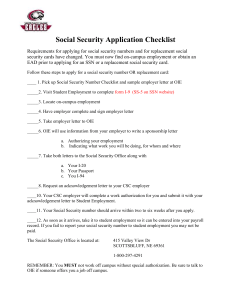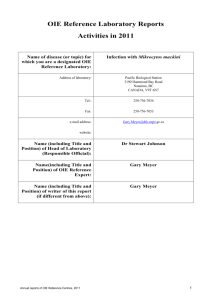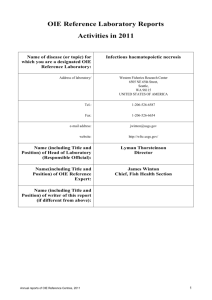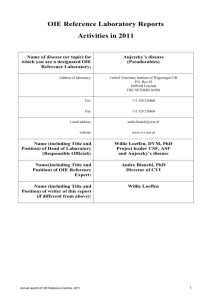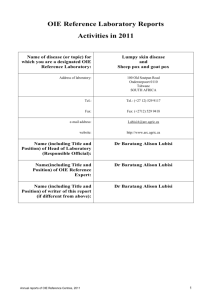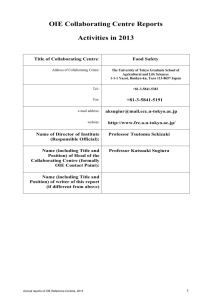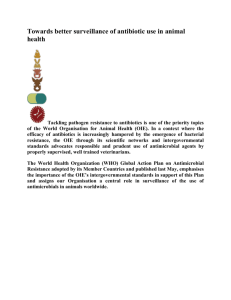Virus Isolation
advertisement
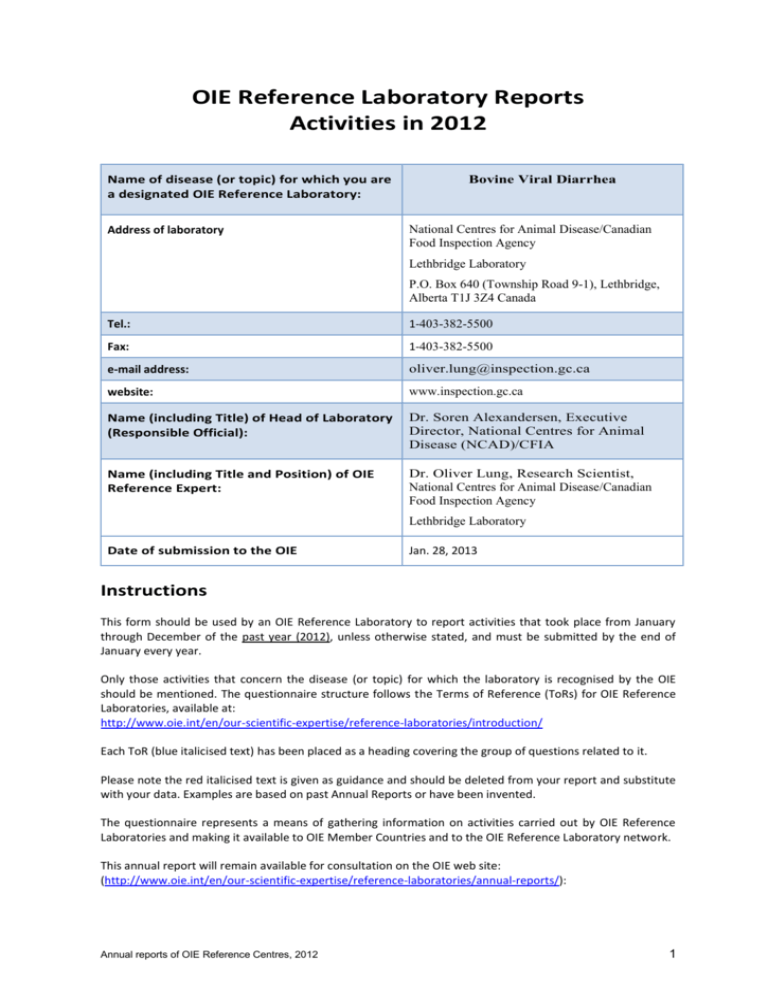
OIE Reference Laboratory Reports Activities in 2012 Name of disease (or topic) for which you are a designated OIE Reference Laboratory: Address of laboratory Bovine Viral Diarrhea National Centres for Animal Disease/Canadian Food Inspection Agency Lethbridge Laboratory P.O. Box 640 (Township Road 9-1), Lethbridge, Alberta T1J 3Z4 Canada Tel.: 1-403-382-5500 Fax: 1-403-382-5500 e-mail address: oliver.lung@inspection.gc.ca website: www.inspection.gc.ca Name (including Title) of Head of Laboratory (Responsible Official): Dr. Soren Alexandersen, Executive Director, National Centres for Animal Disease (NCAD)/CFIA Name (including Title and Position) of OIE Reference Expert: Dr. Oliver Lung, Research Scientist, National Centres for Animal Disease/Canadian Food Inspection Agency Lethbridge Laboratory Date of submission to the OIE Jan. 28, 2013 Instructions This form should be used by an OIE Reference Laboratory to report activities that took place from January through December of the past year (2012), unless otherwise stated, and must be submitted by the end of January every year. Only those activities that concern the disease (or topic) for which the laboratory is recognised by the OIE should be mentioned. The questionnaire structure follows the Terms of Reference (ToRs) for OIE Reference Laboratories, available at: http://www.oie.int/en/our-scientific-expertise/reference-laboratories/introduction/ Each ToR (blue italicised text) has been placed as a heading covering the group of questions related to it. Please note the red italicised text is given as guidance and should be deleted from your report and substitute with your data. Examples are based on past Annual Reports or have been invented. The questionnaire represents a means of gathering information on activities carried out by OIE Reference Laboratories and making it available to OIE Member Countries and to the OIE Reference Laboratory network. This annual report will remain available for consultation on the OIE web site: (http://www.oie.int/en/our-scientific-expertise/reference-laboratories/annual-reports/): Annual reports of OIE Reference Centres, 2012 1 OIE RL for « Bovine Viral Diarrhea » – « Dr. Oliver Lung » – « Canada » ToR: To use, promote and disseminate diagnostic methods validated according to OIE Standards Total number of test performed last year Test recommended by the OIE Indirect diagnostic tests Nationally Serum neutralization 7202 Direct diagnostic tests Nationally Virus Isolation 1077 Immunoperoxidase Monolayer 3224 Internationally Internationally ToR: To develop reference material in accordance with OIE requirements, and implement and promote the application of OIE Standards. To store and distribute to national laboratories biological reference products and any other reagents used in the diagnosis and control of the designated pathogens or disease. 2. Did your laboratory produce or store imported standard reference reagents officially recognised by the OIE or other international bodies? X 3. Yes Did your laboratory supply standard reference reagents to OIE Member Countries? X Yes Name of recipient OIE Member Countries and of institutions Produced/ stored Amount supplied internationally (ml, mg) Control sera against BVD type 1 suitable for use as international standards Produced/ 10 ml Nil Canada (Canadian Food Inspection Agency, Winnipeg Laboratory) Control sera against BVD type 2 suitable for use as international standards Produced/ 10 ml Nil Canada (Canadian Food Inspection Agency, Winnipeg Laboratory) 4. Related diagnostic test No Amount supplied nationally (ml, mg) Type of reagent available Stored Stored Did your laboratory produce diagnostic reagents other than the OIE-approved standard reference reagents? X 5. Yes No Did your laboratory produce vaccines? Yes 2 No X No Annual reports of OIE Reference Centres, 2012 OIE RL for « Bovine Viral Diarrhea » – « Dr. Oliver Lung » – « Canada » 6. Did your laboratory supply vaccines to OIE Member Countries? Yes X No ToR: To develop, standardise and validate, according to OIE Standards, new procedures for diagnosis and control of the designated pathogens or diseases 7. Did your laboratory develop new diagnostic methods validated according to OIE Standards for the designated pathogen or disease? X 8. Yes No Did your laboratory develop new vaccines according to OIE Standards for the designated pathogen or disease? Yes X Name of the new test or diagnostic method or vaccine developed Electronic Microarray for Detection of High Consequence Viruses in Cattle Validation of commercially available ELISA Kits for the detection of Antibodies against BVDV No Description and References (Publication, website, etc.) Manuscript in preparation CFIA Lethbridge Laboratory Research Report 2013 (In preperation) ToR: To provide diagnostic testing facilities, and, where appropriate, scientific and technical advice on disease control measures to OIE Member Countries 9. Did your laboratory carry out diagnostic testing for other OIE Member Countries? Yes 10. X No Did your laboratory provide expert advice in technical consultancies on the request of an OIE Member Country? X Yes No Name of the OIE Member Country receiving a technical consultancy Canada How the advice was provided Purpose Comparison of BVD-IP tests and BVDPCR test Remote assistance ToR: To carry out and/or coordinate scientific and technical studies in collaboration with other laboratories, centres or organisations 11. Did your laboratory participate in international scientific studies in collaboration with OIE Member Countries other than the own? X Yes Annual reports of OIE Reference Laboratories, 2012 No 3 OIE RL for « Bovine Viral Diarrhea » – « Dr. Oliver Lung » – « Canada » Partners (Institutions) OIE Member Countries involved other than your country Title of the study Duration Purpose of the study Portable Electronic Microarrays for Agrobioterrorism: Detection and Typing of High Consequence Agents 2 years Development of rapid multiplex assays for simultaneous detection of multiple viruses of cattle including BVDV Pirbright Institute, UK; Nexogen Inc., USA USA, UK Portable Electronic Microarrays for Agrobioterrorism: Detection and Typing of High Consequence Agents in Swine 2 years Development of rapid multiplex assays for simultaneous detection and typing of eight viruses of swine Pirbright Institute, UK; EU Reference Laboratory for CSF, Germany; Plum Island Animal Disease Center, APHIS, USDA, USA; Nexogen Inc., USA UK, Germany, USA ToR: To collect, process, analyse, publish and disseminate epizootiological data relevant to the designated pathogens or diseases 12. Did your Laboratory collect epizootiological data relevant to international disease control? X 13. Yes Did your laboratory disseminate epizootiological data that had been processed and analysed? Yes 14. No X No What method of dissemination of information is most often used by your laboratory? (Indicate in the appropriate box the number by category) a) .........................................................................................Articles published in peer-reviewed journals: ........................................................................... b) ........................................................................ International ......................................................................................... National ......................................................................................... conferences: conferences: c) ........................................................................ Other: Statistics is collected on a regular basis and is available for dissemination. ToR: To provide scientific and technical training for personnel from OIE Member Countries To recommend the prescribed and alternative tests or vaccines as OIE Standards 15. Did your laboratory provide scientific and technical training to laboratory personnel from other OIE Member Countries? Yes X No a) .........................................................................................Technical visits: 4 Annual reports of OIE Reference Centres, 2012 OIE RL for « Bovine Viral Diarrhea » – « Dr. Oliver Lung » – « Canada » b) .........................................................................................Seminars: c) .........................................................................................Hands-on ......................................................................................... training courses: d) .........................................................................................Internships (>1 month): ToR: To maintain a system of quality assurance, biosafety and biosecurity relevant for the pathogen and the disease concerned 16. Does your laboratory have a Quality Management System certified according to an International Standard? X Yes No Quality management system adopted ISO 17025 17. Is your laboratory accredited by an international accreditation body? X Yes No Test for which your laboratory is accredited Accreditation body Serum neutralization ILAC Virus Isolation ILAC Immunoperoxidase Monolayer ILAC 18. Does your laboratory maintain a “biorisk management system” for the pathogen and the disease concerned? (See Manual of Diagnostic Tests and Vaccines for Terrestrial Animals 2012, Chapter 1.1.3 or Manual of Diagnostic Tests for Aquatic Animals 2012, Chapter 1.1.1) X Yes No ToR: To organise and participate in scientific meetings on behalf of the OIE 19. Did your laboratory organise scientific meetings on behalf of the OIE? Yes 20. X No Did your laboratory participate in scientific meetings on behalf of the OIE? Yes X No ToR: To establish and maintain a network with other OIE Reference Laboratories designated for the same pathogen or disease and organise regular inter-laboratory proficiency testing to ensure comparability of results 21. Did your laboratory exchange information with other OIE Reference Laboratories designated for the same pathogen or disease? X Yes Annual reports of OIE Reference Laboratories, 2012 No 5 OIE RL for « Bovine Viral Diarrhea » – « Dr. Oliver Lung » – « Canada » 22. Was your laboratory involved in maintaining a network with OIE Reference Laboratories designated for the same pathogen or disease by organising or participating in proficiency tests? Yes 23. X No Did your laboratory collaborate with other OIE Reference Laboratories for the same disease on scientific research projects for the diagnosis or control of the pathogen of interest? Yes X No ToR: To organise inter-laboratory proficiency testing with laboratories other than OIE Reference Laboratories for the same pathogens and diseases to ensure equivalence of results. 24. Did your laboratory organise or participate in inter-laboratory proficiency tests with laboratories other than OIE Reference Laboratories for the same disease? X Yes No Purpose for inter-laboratory test comparisons1 No. participating laboratories Participating OIE Member Countries Participated in diagnostic proficiency testing Multiple USA and Canada ToR: To place expert consultants at the disposal of the OIE 25. Did your laboratory place expert consultants at the disposal of the OIE? X Yes Kind of consultancy Provision of comments on OIE standards 1 6 No Location Subject (facultative ) Chapter on bovine viral diarrhoea See Interlaboratory test comparisons in: Laboratory Proficiency Testing at: www.oie.int/en/our-scientific-expertise/reference-laboratories/proficiency-testing see point 1.3 Annual reports of OIE Reference Centres, 2012
